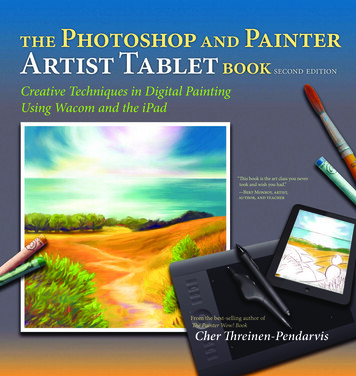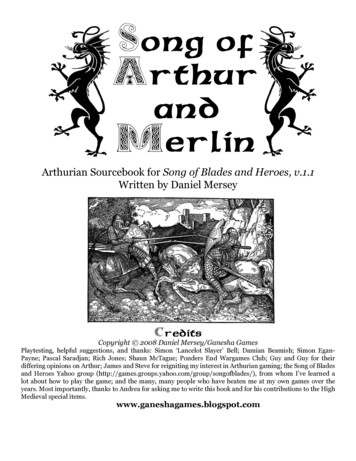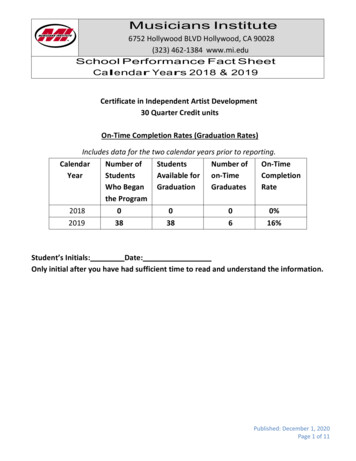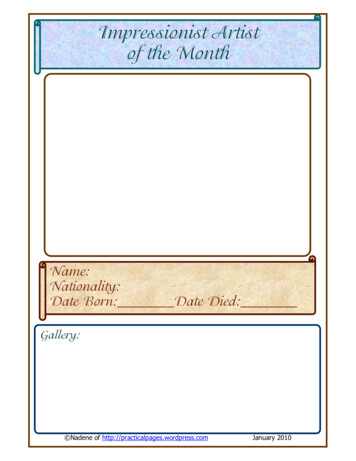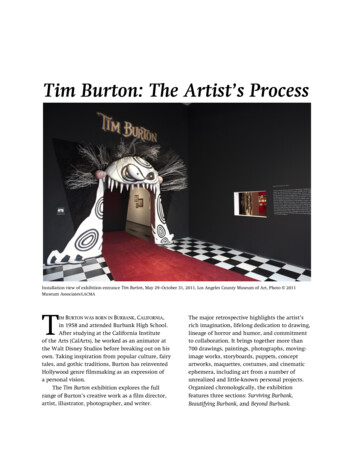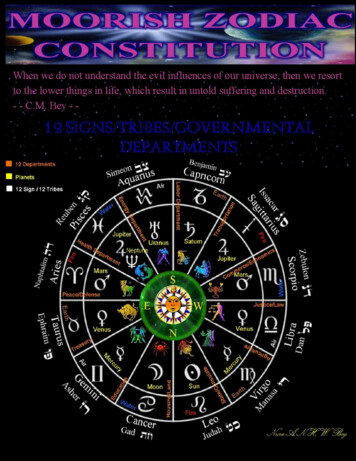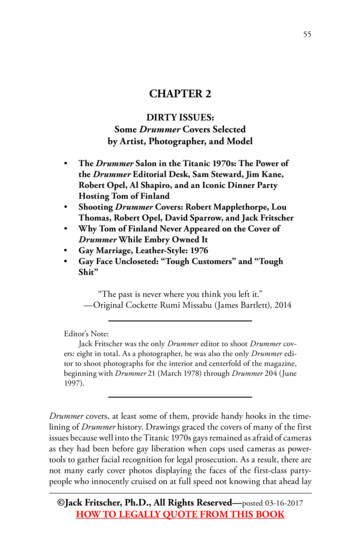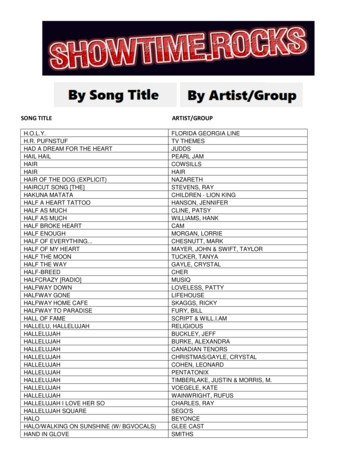
Transcription
Arthur Szyk: Activist Artist andBook Illustrator ExtraordinaireAutumn 2011
Table of ContentsIntroductionCase One: Portfolio ExtraordinaireCase Two: Illustrator of Tales for Adults andChildrenCase Three: Preserving the Faith – Defendingthe FaithCase Four: Szyk and PhilatelyAcknowledgementsAppendix: Irvin Ungar, “Arthur Szyk: BookIllustrator Extraordinaire!”
Portrait of Arthur Szyk (1894 – 1951)
IntroductionDuring his lifetime (1894-1951), Arthur Szyk—pronounced "Schick”—earned fame inPoland, France, Canada, the United States, and Israel for his exquisite book illustrations,religious art, miniatures, political caricatures, and postage stamp designs. An activist-artist,Szyk conceived of art as a means to make a case for social justice. Szyk, who was trainedin art in France but identified himself as a Pole and a Jew, documented the atrocities ofHitler, Hirohito, and Mussolini and caricaturized these fascist leaders. In art, he workedfor a Jewish homeland but also championed displaced and oppressed Poles, Brits, NativeAmericans, African Americans, and Indonesian Muslims (facing prejudice from theDutch in the 1940s). Szyk's magnum opus, the Szyk Haggadah, debuted in London in1939. Following its publication, Szyk immigrated to the United States in 1940 in the wakeof the Holocaust.Hailed the greatest miniaturist since the 16th century, Szyk became virtually forgottenfollowing his death in 1951. Until now, you may never even have heard of him. Theextraordinary output of Arthur Szyk was the subject of the 23rd annual Fox-AdlerLecture delivered by Irvin Ungar, foremost Szyk scholar and art dealer and majorproponent of a Szyk renaissance. In a recent interview for AIGA (a professionalassociation for design), Ungar notes that Szyk's "unique style . . . combines use of colorwith a miniaturist's attention to detail[;] Szyk departs from all schools of art and yetembraces many of them." To Ungar, "Szyk's prodigious output—illustrated books, andmagazine and newspaper political art, as well as nationalistic portraits and illuminatedreligious works—would together qualify him as a school of art in his own right."
These four cases illuminate Szyk’s multifaceted oeuvre—a "school of art in [its] own right."Case 1 entitled "Portfolio Extraordinaire" showcases Szyk’s artistic range and the extraordinaryrange of texts he illustrated: fairy tales to the Bible, portraits of George Washington to postagestamps. Case 2 entitled "Illustrator of Tales for Adults and Children" showcases Szyk’srenowned illustrations for Hans Christian Andersen’s fairy tales alongside The Arabian Nights andThe Canterbury Tales. Case 3, "Preserving the Faith, Defending the Faith," features Szyk's role asdefender of justice. Caricatures of Hitler in The New Order (1941) show Szyk to be a "hater ofhatred" while his illustrations for The Book of Job and The Haggadah demonstrate pride in hisJewish heritage during a time when it was dangerous to be Jewish. Cases 3 and 4 documentSzyk's Zionist efforts. Case 4, "Szyk and Philately," features postage labels for the Zionestmovement as well as stamps for Israel, the Jewish state Szyk was so proud of, and Liberia, theAfrican nation America helped to found.This exhibit was mounted by Catherine J. Golden, Professor of English; Wendy Anthony,Special Collections Curator; and Lollie Abramson, Coordinator of Jewish Life, and was ondisplay in the Harris Lobby in the Scribner Library in August and September 2011. This bookletwas designed by Daniel Johnstone ’14 and Catherine J. Golden.
Case 1: Portfolio ExtraordinaireWe see side-by-side Szyk’s illustrations for a 1946 edition ofChaucer’s 14th-century Canterbury Tales and a 1946 edition of TheRubaiyat by Omar Khayam (1048-1131).
Portfolio ExtraordinaireThe same artist who envisioned the first American president in GeorgeWashington and His Times: The American War for Independence (1931) alsocreated Israeli postage stamp designs printed in 1950, all displayingvivid detail and color. Szyk also created playing card designs andtheatre sets, further testimony to his extraordinary range as an artist.
Case 2: Illustrator of Tales for Adults and ChildrenIn this 1945 edition of Hans Christian Andersen’s late nineteenth-century fairy tales, Szyk capturesAndersen’s voice as an author: we see vivid details of realism both in human forms and the natural worldblended with elements of the fantastic. In 1946, Szyk accepted the commission to illustrate The Arabian Nights(pictured above right with Andersen’s tales) and Geoffrey Chaucer’s The Canterbury Tales.
“The Girl Who Trod on a Loaf” from Andersen’sFairy Tales, 1946Szyk’s book illustrations as in his image forHans Christian Andersen’s 1859 story “TheGirl Who Trod on a Loaf” again foregroundcolor and pile in detail as they tell the story ofvain and ambitious Inge, who falls through theearth and is punished for her wastefulness of aloaf of bread sacrificed to keep her dress clean(her vanity). This plate demonstrates Szyk’sability to assemble a range of characters andobjects into one panel that conveys a wholenarrative—past, present, and future—makinghis art what Gotthold Ephraim Lessing calls a“pregnant moment” in Laocoön.
Szyk memorably creates“The Wife of Bath” fromThe Canterbury Tales, 1946.
Case 3: Preserving the Faith – Defending the Faith“I am but a Jew praying in art, and if Ihave succeeded to some degree, if I havegained the power of reception amongthe elite of the world, I owe it all to theteachings, traditions, and eternal virtuesof my people.”–Arthur SzykAnti-Christ: Szyk draws Hitler
The Szyk Passover Haggadah is the most widely recognized of his Biblical works. The original textoffered stylized representations of European Jewry and portrayed Pharaoh’s army with swastikas. Szykwas unable to get anyone to publish such blatant anti-Nazism, and the original artwork was removed.Title Page from the Szyk Haggadah, 1936
Szyk illustrated the Books of Job, Esther, Ruth, and Song of Songs.
In “Satan Leads the Ball” (above, 1942), Szyk caricaturizes Hitler, Mussolini, Hirohito and other fascists. Anactivist artist, Szyk had a lifelong commitment to helping the Jewish People. He used his art as a means to saveEuropean Jewry, fight Hitler, and promote the creation of the Jewish State. In The New Order (1941), Szyk alsomemorably depicted the maniacal powers of destruction, leading the Third Reich to put a bounty on his head.
Szyk’s artwork was recognizable in war bonds,War Department pamphlets, advertisements (e.g.Bromo-Seltzer), and political cartoons to supportthe Allied cause. According to Esquire Magazine,his posters were more popular among the GI’sthan those of pinup girls. His message to savethe Jews was worldwide; for example, in apamphlet for “FONDO TEL JAY,” the Fund forLife (c. 1941), Szyk rallied the Jews of SouthAmerica in a call to abolish the “White Paper” inwhich England limited Jewish emigration toPalestine.
Case 4: Szyk and PhilatelyTo the left are Szyk’s Israeli festival stamps of 1950, mounted on a card with hissignature. The design features the six-pointed Jewish star. In the bottom center ofthe stamp appears a lulav and an etrog, ritual symbols of Sukkot, the Jewishholiday of the harvest.In his activist efforts, Szyk also created drawings for “poster stamps” for theEmergency Committee to save the Jewish People of Europe. These movingdesigns for use on personal correspondence, business letters, and packages were to“show all people that American will not tolerate this planned murder” of Jewsand to support the creation of a Jewish homeland.
Szyk created six stamp designs of varying denominations forLiberia in 1949. In one design, we see an American flag.Szyk illuminates how freed American slaves, with the helpof the American Colonization Society, colonized the areanow known as Liberia in 1820 and, in 1847, founded theRepublic of Liberia. Modeling its government onthe United States government, Liberia named its capitalMonrovia after James Monroe, the fifth US president.
AcknowledgementsMany of these books and the postage stamps comefrom the collection of Norman M. Fox. We arevery grateful to Norman Fox for loaning them toSkidmore College for this exhibition. We aregrateful to the Honors Forum for funding theprinting of this exhibition booklet.We offer a special thanks also to Irvin Ungar,foremost Szyk scholar, for delivering an excellentlecture on Arthur Szyk entitled “Arthur Szyk:Book Illustrator Extraordinaire!” and for allowingus to reprint it in this exhibition pamphlet.
AppendixArthur Szyk: Book Illustrator Extraordinaire!This month, September 2011, we commemorate the 60th anniversary of Arthur Szykʼs death. Szyk was born in Lodz,Poland in 1894 into a well-to-do Polish-Jewish family. In 1940, he immigrated to the United States, living in New York CityManhattanʼs upper west side, moving to New Canaan, Connecticut in 1946, where he became a US citizen in 1948, anddied in 1951 at age 57.theAt age 6, it was said that the young artist was already drawing images of the Boxer rebellion in China, and that at age 11 hewas expelled from Trade School in Russian dominated Lodz for drawing pictures that made fun of the Tsar. It is clear frombeginning that Szyk was interested in art and politics, with each phase of his life fused together with this combination as if toform one long string of connecting vertebrae on a cord and therefore, at the very core of his body of work. And while this is,of course, obvious in his extensive propaganda art during both World War I and World War II and their aftermaths, wevery clearly witness the artistʼs politics at the forefront in many of his most celebrated illustrated books and portfolios.In 1910, as a 16 year-old, teenager Arthur Szyk went off to study in Paris, enrolling at the Academie Julien, where he usedhis drawing of bold satire and caricature to comment on the events of the day, often sending his sketches and cartoons backto his hometown of Lodz where they were published in Polish newspapers. Following a visit to Palestine in 1914 and hissubsequent conscription into the Russian army at the outbreak of World War I, from which he soon fled, Szyk returned toLodz, and was later appointed director of art propaganda for Poland in 1919 in its war against the Soviet Union. In thatsame year, the artist collaborated with his writer friend, Julian Tuwin, to create his first illustrated political book,Revolution in Germany, a satirical and witty attack on Post World War I German society. Here, for example, Szyk comicallyportrays Imperial Germany, Germania, as a buxom female wearing famous iron bra cups.
In the early 1920s Szyk settled in Paris and had numerous successful one-man art exhibitions. It was, at that time, hebegan to illustrate several fine limited edition art books. The first, Le Livre DʼEsther, The Book of Esther, published in1925, demonstrated Szykʼs familiarity with Persian and Oriental miniatures as well as Assyrian sculpture-like images.Recounting the biblical narrative in which wicked Hamanʼs plot to destroy the Jews of ancient Persia is thwarted byJewish Queen Esther and her uncle Mordechai, Szyk saw this, note Szyk as witness in the bottom right, -- Szyk sawthe Book of Esther as a story of his peopleʼs liberation, and response to anti-Semitism, a constant theme he vigorouslyaddressed throughout his life. Szyk also illustrated The Book of Esther a second time in 1950.In the mid 1920s two other fine limited edition books by Szyk appeared, both stenciled and hand-colored pochoirworks. The first The Temptation of Saint Anthony is very different in style from any of Szykʼs illustrated books, verymodern and surreal, almost Dali-esque in their dreaminess, but fitting with the storyʼs narrative. About 350 copieswere produced, selling for 150 each at the time. Following on this work, Szykʼs The Well of Jacob was published in1927. Here a young Jewish dancer from Constantinople goes off to Palestine where she embraces the up-building ofthe Land, and after becoming financially well-off, supports the Jewish colonies there. Only 327 copies were produced.The paintings here while reflecting sophisticated color combinations, do not possess Szykʼs usual ornate and detaileddecorations, which shall become clear very shortly.The Jew Who Laughs, a two-volume small paperback work, with simple line, pen and ink drawings, quite unlike hisdeluxe books. Both volumes contained jokes and vignettes, about Jewish life, sometimes unflattering. I suspect this is awork Szyk wished he had never done, contrasting so very sharply, not only with his style at the time, but moreimportantly, with the intent of his art. While Szyk found time to engage in regular daily conversations at the Parisiancafes, frequented by Picasso, Hemingway and others, as well as by many Eastern European artists such as LeopoldGottlieb and Chaim Soutine– his steadfast concerns were the anti-Jewish attitudes developing in Germany incombination with the incubating anti-Semitism in Poland. It was for that reason, in 1926, coinciding specifically withthe political coup of Jozef Pilsudski in Poland, which Szyk supported; he focused his attention to illuminating andinterpreting a historic document that has often been referred to, as the “Jewish Magna Carta”, dedicating it toMarshall Pilsudski. Entitled The Statute of Kalisz, Szyk’s 45-page monumental masterpiece, watercolor and gouacheminiatures on paper, completed between 1926 and 1928, was by far his most significant body of work during his Parisperiod. In it he highlighted the religious liberties and civil privileges that were granted to the Jews in a charter by thePolish Duke Boleslaw the Pious in the town of Kalisz in 1264, and renewed several times thereafter by subsequentPolish rulers in the following centuries. With collective Jewish freedoms being threatened on numerous fronts in hisown day, Szyk felt it necessary to recall t
religious art, miniatures, political caricatures, and postage stamp designs. An activist-artist, Szyk conceived of art as a means to make a case for social justice. Szyk, who was trained in art in France but identified himself as a Pole and a Jew, documented the atrocities of Hitler, Hirohito, and Mussolini and caricaturized these fascist leaders. In art, he worked for a Jewish homeland but .

